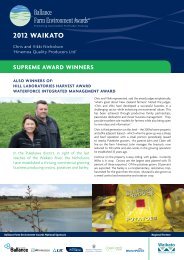Dairy's role in sustaining New Zealand - Fonterra
Dairy's role in sustaining New Zealand - Fonterra
Dairy's role in sustaining New Zealand - Fonterra
Create successful ePaper yourself
Turn your PDF publications into a flip-book with our unique Google optimized e-Paper software.
32 Dairy’s <strong>role</strong> <strong>in</strong> generat<strong>in</strong>g growth<br />
Appendix C Limitations of analysis<br />
• Aggregation bias. We have not split out the dairy sector, but use aggregated dairy<br />
farm<strong>in</strong>g and dairy process<strong>in</strong>g <strong>in</strong>dustries. This leads to aggregation bias. For example,<br />
irrigated and non-irrigated farm<strong>in</strong>g practices and <strong>in</strong>dustry structures are likely to be quite<br />
different, and at present this is not captured with<strong>in</strong> our modell<strong>in</strong>g. Given adequate time,<br />
the model can be disaggregated to more accurately model the specific dairy sector.<br />
• Foreign debt account<strong>in</strong>g. We employ a standard ‘MONASH’method for account<strong>in</strong>g for<br />
the foreign debts – changes <strong>in</strong> net foreign liabilities come about if our <strong>in</strong>vestment is not<br />
met by domestic sav<strong>in</strong>gs. We pay <strong>in</strong>terest on foreign debt that is subtracted from national<br />
<strong>in</strong>come. The <strong>in</strong>terest, <strong>in</strong> foreign currency, is converted to domestic currency by the<br />
exchange rate. In this simulation, the exchange rate appreciation leads to a decrease <strong>in</strong><br />
the domestic currency value of the <strong>in</strong>terest repayments. It could be argued that much of<br />
the <strong>in</strong>terest on this foreign debt is likely to be dividend payments on equity. In this case,<br />
the appreciation of the exchange rate should not decrease overseas payments.<br />
• ‘Top-down’ regional modell<strong>in</strong>g. Regional data is by far the most difficult data to obta<strong>in</strong><br />
across the diverse range of <strong>in</strong>dustries and commodities that we have <strong>in</strong>corporated with<strong>in</strong><br />
our model. ‘Bottom-up’regional modell<strong>in</strong>g provides a clearer picture of regional activity<br />
and <strong>in</strong>-particular cross-region flows, however requires significant data resources. The topdown<br />
approach here provides <strong>in</strong>dicative regional splits.<br />
• Model structure. The CGE model is based on Statistics <strong>New</strong> <strong>Zealand</strong> Input Output tables,<br />
with decisions based on neoclassical economics. Structural changes to the economy from<br />
the reforms are therefore not captured <strong>in</strong> the modell<strong>in</strong>g, nor are any non-competitive<br />
market structures. This means the distributional elements of the results may differ <strong>in</strong><br />
reality if firms with market power do not pass on benefits.
















